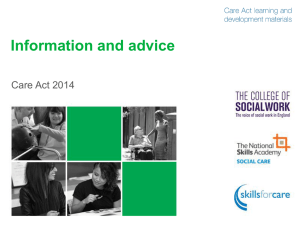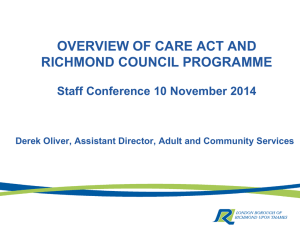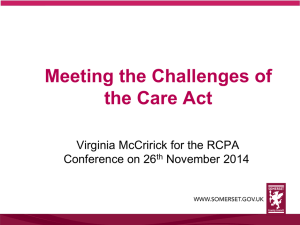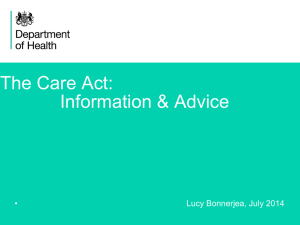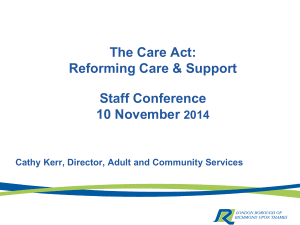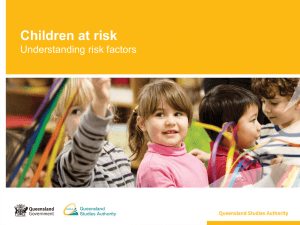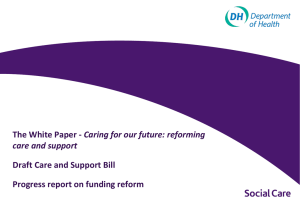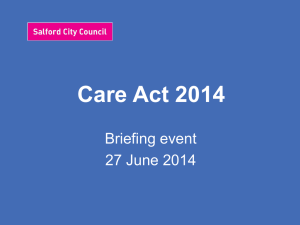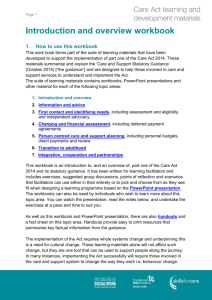Introduction and overview slide pack
advertisement
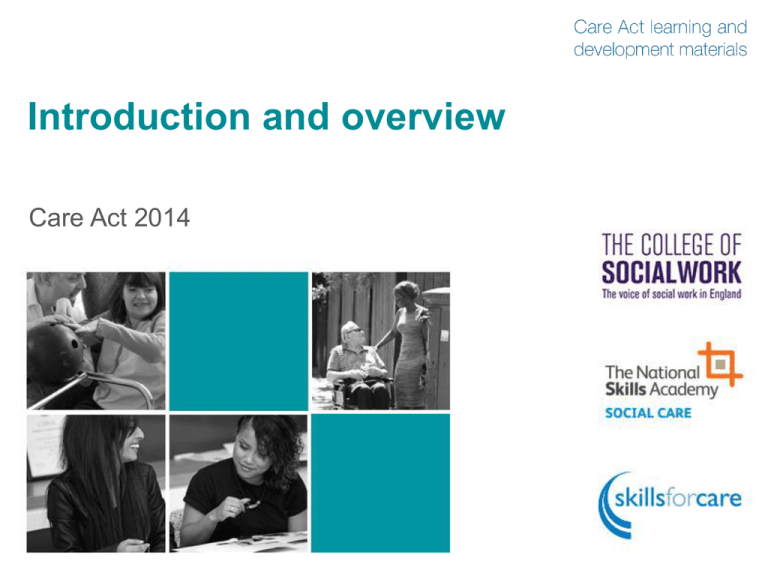
Introduction and overview Care Act 2014 What is this module about? Part 1 of the Care Act and its statutory guidance Who’s it for? Adult social care as well as wider elements of local authorities Health and other local authority partner organisations Social care provider and support organisations in all sectors Those involved in the governance of these organisations and people who work, care, support and volunteer in them Professionals and practitioners What might you learn? The basic framework of the Act and its key components The core principles behind the Act and what it is intended to deliver Some implications of the Act and key changes 2 Outline of content Introduction and background What is the Act trying to achieve? The framework of the Act The wellbeing principle General responsibilities New duties Changes to assessment, eligibility and care and support planning processes What might this mean for people needing care and support? What might this mean for local authorities and partner organisations? Summary 3 Introduction The Care Act received Royal Assent on 14 May 2014 The Act is in three parts: 1. Care and support 2. Care standards 3. Health Part 1 of the Act consolidates and modernises the framework of care and support law: New duties for local authorities New rights for service users and carers 4 The Care Act 2014 replaces many previous laws National Assistance Act 1948 1948 1960… NHS and Community Care Act 1990 1970… Chronically Sick and Disabled Person Act 1970 1980... Community Care (Direct Payments) Act 1996 1990… 2000… 2010… Carers (Recognition and Services) Act 1995 5 What is the Act trying to achieve? That care and support: is clearer and fairer promotes people’s wellbeing enables people to prevent and delay the need for care and support, and carers to maintain their caring role puts people in control of their lives so they can pursue opportunities to realise their potential 6 An integrated Act Different sections of the Act are designed to work together Local authority wide Overlap with Children and Families, including transitions Partnerships and integration Leadership 7 Legislation, regulations and guidance Primary legislation – the Care Act 2014 Legal duties and powers Secondary legislation – the regulations More detail on critical requirements Statutory guidance Guidance on how to meet the legal obligations in the Act Implementation support Best practice guidance, toolkits and other products that help support implementation 8 The framework of the Act and its statutory guidance General Underpinning responsibilities and Key processes principle key duties Wellbeing Prevention Assessment and eligibility Integration, partnerships Charging and and transitions financial assessment Information, advice and Care and support advocacy planning Diversity of provision and market oversight Personal budgets and direct payments Safeguarding Review 9 The wellbeing principle “The general duty of a local authority, … in the case of an individual, is to promote that individual’s wellbeing”. Wellbeing broadly defined: 9 areas in particular Local authorities should also have regard to other key principles when carrying out their activities, such as beginning with the assumption that the individual is best-placed to judge their well-being 10 New responsibilities of local authorities towards all local people Arranging services or taking other steps to prevent, reduce or delay peoples’ needs for care and support Provision of information and advice, including independent financial advice Promoting diversity and quality in the market of care providers so that there are services/supports for people to choose from 11 New duties – integration and market oversight A statutory requirement to collaborate and cooperate with other public authorities, including duty to promote integration with NHS and other services Duty for local authorities to step in to ensure that no one is left without the care they need if their service closes because of business failure CQC oversight of financial health of providers most difficult to replace were they to fail and to provide assistance to local authorities if providers do fail 12 New duties – advocacy, safeguarding and transitions A duty to arrange independent advocacy if a person would otherwise be unable to participate in or understand the care and support system New statutory framework for protecting adults from neglect and abuse. Duty on local authorities to investigate suspected abuse or neglect, past or present, experienced by adults still living and deceased Duty to assess young people and their carers in advance of transition from children’s to adult services, where likely to need care and support as an adult 13 Changes to assessment, eligibility and financial assessment processes Person appears to have needs Assessment Are their needs eligible? YES Deferred payment agreement Financial assessment NO (written explanation) Advice and information 14 Changes to care and support planning processes 15 What might this mean for people needing care and support? Better access to information and advice, preventative services, and assessment of need An entitlement to care and support A cap on care expenditure which an individual is liable for comes into effect from April 2016 A common system across the country: Continuity of care Fair Access to Care Services (FACS) replaced by a national eligibility threshold 16 How will people experience the new system in 2016/17? If you have care and support needs, you could be supported by… Assessment of the care and support you need, and eligibility for state support Information and advice on local services and how much they cost Reablement, rehabilitation and other free services How much you might pay for your care and support depends on your financial situation Support from family, networks community… You have a financial assessment to see what you have to pay Every year the local authority • Reviews your care needs and financial situation • Keeps a record, from April 2016, called a care account, of how much eligible care you have needed in total Costs are capped There is a cap on expenditure on eligible care from April 2016 What does this mean for carers? The Care Act strengthens the rights and recognition of carers: Improved access to information and advocacy should make it easier for carers to access support and plan for their future needs The emphasis on prevention will mean that carers should receive support early on and before reaching crisis point Adults and carers have the same rights to an assessment on the appearance of needs A local authority must meet eligible needs of carers and prepare a support plan A carer should be kept informed of the care and support plan of the person they care for Children and Families Act 2014 18 What might this mean for local authorities? New duties and responsibilities Changes to local systems and processes More assessments and support plans Responsibilities towards all local people Better understanding of self funders and the care market needed Training and development of the workforce Costs of reforms Preparation for reforms needed 19 What might this mean for local authority partners and care organisations? NHS, housing and children’s services share the duty to integrate Partners and providers will find: - They may need to respond to the wellbeing principle - Greater local authority focus on promoting diversity and quality in the market and market intelligence about self-funders needed - Greater local authority involvement in services focused on prevention and delay - National, not local, eligibility criteria - New, statutory safeguarding arrangements 20 Summary A significant piece of legislation that modernises the framework of care and support law, bringing in: New duties for local authorities New rights for service users and carers It aims to make care and support clearer and fairer and to put people’s wellbeing at the centre of decisions, and embed and extend personalisation Local authorities have new responsibilities towards all local people, including self funders There are significant changes to the way that people will access the care and support system 21
